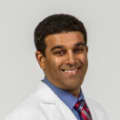A 1- or 2-day hospital stay is typical after knee replacement surgery. Some patients may be kept longer if there is a medical concern.

Early stages of recovery from knee replacement focus on managing pain and ensuring safety.
While in the hospital, the medical staff’s main goals are:
- Controlling pain
- Preventing and watching for signs of complications
- Teaching the patient how to use a walker or other assistive device and perform basic tasks, like getting in and out of bed
A patient may wake up after surgery feeling groggy and attached to an IV and other medical devices. A day or two later, at the time of discharge, they will be able to walk with a walker or other assistive device and perform many self-care tasks independently.
In This Article:
- Knee Replacement Recovery Timeline
- Knee Replacement Surgery: Postsurgical Care
- Knee Replacement Recovery: Discharge to 21 days
- Knee Replacement Recovery: Weeks 4 to 6
- Knee Replacement Recovery: Week 8 and Beyond
Immediately After Knee Replacement Surgery
A patient will typically wake up from anesthesia in a recovery room. After 1 to 2 hours the patient will be moved to a hospital room where family and friends can visit.
During the first few hours:
- There is typically little to no knee pain. The anesthesia and nerve block, if one was used, will not be completely worn off yet.
- The patient may experience nausea, a common side effect of the anesthesia.
- The knee will be well bandaged and leg will be propped up or elevated.
- The patient may have a urinary catheter, a drain at the incision site, and an IV delivering fluids. The catheter, if present, is often removed in the first few hours. The incision drain and IV may remain for the duration of the hospital stay.
Patients can eat solid foods when they feel ready.
Walking After Knee Replacement
Within hours of waking up after surgery, physical therapy will begin. Hospital staff will help the patient out of bed to take a short walk using a walker or other assistive device. The first walk may be to the bathroom. Most patients are able to use the toilet by themselves.
The person may be directed to walk every 1 to 3 hours (during waking hours). By the time of discharge, a person may be able to walk 100 yards or more with an assistive device.
Putting weight on the joint and keeping the body active will aid the healing process and help lower the risk of pneumonia, blood clots, and constipation.
Continuous Passive Motion (CPM) Machines
Some surgeons may have their patients use a continuous passive motion (CPM) machine. A CPM machine slowly moves the leg, causing the knee to repeatedly straighten and bend, while the patient lies on his or her back. A patient may use a CPM machine for up to 8 hours a day, in between sleeping and physical therapy.
The hope is that CPM use will help patients regain range of motion more quickly, facilitating a faster hospital discharge.
Research regarding CPM machines is conflicting. Some studies suggest patients who use a CPM machine regain flexibility sooner, while others do not. 1Harvey LA, Brosseau L, Herbert RD. Continuous passive motion following total knee arthroplasty in people with arthritis. Cochrane Database Syst Rev. 2014 Feb 6;2:CD004260. doi: 10.1002/14651858.CD004260.pub3. Review. PubMed PMID: 24500904.,2Joshi RN, White PB, Murray-Weir M, Alexiades MM, Sculco TP, Ranawat AS. Prospective Randomized Trial of the Efficacy of Continuous Passive Motion Post Total Knee Arthroplasty: Experience of the Hospital for Special Surgery. J Arthroplasty. 2015 Dec;30(12):2364-9. doi: 10.1016/j.arth.2015.06.006. Epub 2015 Jun 14. PubMed PMID: 26165955.,3Yang X, Li GH, Wang HJ, Wang CY. Continuous Passive Motion After Total Knee Arthroplasty: A Systematic Review and Meta-analysis of Associated Effects on Clinical Outcomes. Arch Phys Med Rehabil. 2019 Sep;100(9):1763-1778. doi: 10.1016/j.apmr.2019.02.001. Epub 2019 Mar 2. Review. PubMed PMID: 30831093. There is no definitive evidence that the CPM affects long-term knee range of motion or knee function. No risks are associated with CPM.
Leaving the Hospital After Knee Replacement Surgery
Before being discharged, the surgeon will want to make sure that pain is controlled and the patient can:
- Walk with the aid of a walker or other assistive device
- Go up and down stairs
- Eat solid food
- Go to the bathroom alone and have a bowel movement
- Get in and out of bed alone, using a walking aid
Patients and their caregivers will also be given instructions on taking care of the incision.
Patients may be discharged home or to a rehabilitation facility. An orthopedic rehabilitation facility has 24-hour nursing care and in-house physical therapists to help patients recuperate.
- 1 Harvey LA, Brosseau L, Herbert RD. Continuous passive motion following total knee arthroplasty in people with arthritis. Cochrane Database Syst Rev. 2014 Feb 6;2:CD004260. doi: 10.1002/14651858.CD004260.pub3. Review. PubMed PMID: 24500904.
- 2 Joshi RN, White PB, Murray-Weir M, Alexiades MM, Sculco TP, Ranawat AS. Prospective Randomized Trial of the Efficacy of Continuous Passive Motion Post Total Knee Arthroplasty: Experience of the Hospital for Special Surgery. J Arthroplasty. 2015 Dec;30(12):2364-9. doi: 10.1016/j.arth.2015.06.006. Epub 2015 Jun 14. PubMed PMID: 26165955.
- 3 Yang X, Li GH, Wang HJ, Wang CY. Continuous Passive Motion After Total Knee Arthroplasty: A Systematic Review and Meta-analysis of Associated Effects on Clinical Outcomes. Arch Phys Med Rehabil. 2019 Sep;100(9):1763-1778. doi: 10.1016/j.apmr.2019.02.001. Epub 2019 Mar 2. Review. PubMed PMID: 30831093.

